Acorn
![Acorn]()
Somewhere between a Dublin and an Apple, the Acorn features a bowl that swells outwards toward the rim and then tapers dramatically inward as it approaches the heel, often going past the transition and shank to create a spur at the bottom of the bowl.
Acrylic
![Acrylic]()
A type of plastic used for the production of stems and often tenons and accent bands, it is prefered for its durability, workability and the fact that, unlike vulcanite, it will not oxidize.
African Block Meerschaum
![African Block Meerschaum]()
This material is sourced in various African countries and has a different composition than meerschaum mined in Turkey. Similar to Turkish meerschaum, though much harder and slightly heavier, it was often used by English pipe factories and can still be seen today. Bowls made from this material are fireproof, and are often stained with light colors. It's common for pipes made from African meerschaum to have the rims stained black by the factory.
Air Cured
![Air Cured]()
This tobacco is dried naturally while being sheltered from sunlight. Burley is the only type of tobacco that is air-cured, so these terms can really be used interchangeably. Some tin descriptions may even note the presence of "air-cured leaf" assuming that the reader is aware that this means Burley. The drying process can be carried out on the whole plant or as individual leaves reach maturity over a period of one to two months. Air Curing results in less sugar, and Burley is less sweet than other tobaccos as a result. Burley also contains more oils and nicotine, producing a stronger tobacco. Burley comes in two strains, White and Dark, and can be processed to make Black Cavendish, Dark Fired Kentucky, and Perique.
Amber
![Amber]()
Amber is fossilized resin, a substance that flows just under the bark of trees. For use in pipe stems, Amber is usually shaped by hand; they are first immersed in oil and then heated, at which point they lose much of their brittle qualities. Amber stems can be easily scratched or chipped if not cared for properly. Though common on pipes of the 19th and early 20th century, amber stems are very rarely made today. There are a few ways to find out if your pipe has a genuine amber stem: Firstly, the tenons are usually made from bone with threads cut (like a screw). Secondly, amber holds a static charge. Remove a tiny fluff of a cotton ball or lint and place it on a desk. Rub the stem vigorously on a flannel shirt or pair of blue jeans to build up a static charge. Hold the stem over the fluff of cotton - genuine amber will pick it up while acrylic will not.
American Blend
![American Blend]()
Traditionally, this tobacco blend consists of Virginia, Burley, and Oriental in varying proportions, often cased with aromatic flavors.
Apple
![Apple]()
The Apple is a rounded version of the Billiard. The bowl is curved on both sides, much like the fruit it's named for, and usually has a round shank.
Army Mount
![Army Mount]()
The "Army Mount" takes care of the issue of mortise/tenon joints being notoriously weak by reinforcing the mortise with a metal band or cap, and by using a stem that doesn't include a tenon, but instead tapers down to point where it can fit into the mortise. This removes the weak point on the stem and the taper reduces the surface area in contact with the mortise, thereby reducing the amount of grip, allowing the stem to be removed easily. When in use the mortise swells and grips the stem, so the stem won't simply fall out of the mount.
Aromatic
![Aromatic]()
Like most blends, aromatics are lightly topped with natural flavorings to provide both added aroma and flavor when smoked. Unlike other blends; however, which utilize additional flavoring agents, such as whiskey, sugar water, and licorice to accentuate the flavors of the tobacco while leaving the natural aroma unfettered, aromatic is used to describe tobaccos which are heavily scented. Often these blends are more moist than non-aromatic blends.
Author
![Author]()
Essentially a Prince with a larger, beefier, squatter bowl and a stem that can bend as much as 1/8 to 1/4.
Band
![Band]()
Widely used for decorative purposes, a band of nickel, silver, gold, acrylic, or other materials can be found at the very end of the shank, just before the transition from shank to stem. Originally these were used to reinforce the mortise, or as aftermarket repairs to a broken mortise or shank.
Bent
![Bent]()
A "bent" is simply a catch-all term for a pipe bearing some degree of bend in the transition, shank, and/or stem. The bowl will vary in form, and most classic shapes can be found in both bent and straight variants.
Billiard
![Billiard]()
Possibly the most ubiquitous of the pipe shapes, the Billiard has a cylindrical bowl, a shank that is equal in length to the height of the bowl and can wear any stem type while still remaining a Billiard. Variants include the longer shanked Lumberman, Lovat, Canadian, and Liverpool, as well as the higher bowled Stack or Chimney.
Birdseye
![Birdseye]()
Birdseye is the grain of the burl as seen on its end and is so named because it looks like a grouping of small eyes. Depending on the orientation of the briar when it is cut, birdseye can appear on any part of the pipe.
Bit
![Bit]()
The bit is the part of the pipe that fits in the mouth. It generally refers to the entire stem, but most often describes the last inch of the pipe (which includes the button and slot).
Blowfish
![Blowfish]()
A modern shape with origins in the Danish school, and now popular amongst artisans far and wide, particularly those of Japan and the US. Though the interpretations, and re-interpretations, of this shape are many, the most basic form is a rounded, Apple-like bowl design with panels of (usually) differing size to either flank. Typically this shape is made with the briar oriented to show off birdseye grain on the panels.
Bowl
![Bowl]()
The bowl is the part of the pipe which holds the tobacco chamber.
Bowl Coating
![Bowl Coating]()
Bowl Coating is what many (though not all) pipemakers brush inside the tobacco chamber. It became a practice to help build cake and reduce the risk of burnout during the initial smokes - which can sometimes be considered harsh. The practice is highly debated among pipemakers and sometimes among customers, but it's simply a matter of personal opinion and aesthetic.
Brandy
![Brandy]()
A quite popular shape amongst Danish carvers, the Brandy features a wide base and tapers inward towards a more narrow chamber mouth. They traditionally sport a tapered stem and around 1/4 bend, though variations run the gamut of bend and stem type.
Briar
![Briar]()
Briar is the primary wood from which tobacco pipes are made. The name is a corruption of the French word "bruyere," or heath tree, a low shrub found throughout Europe, though mainly around the Mediterranean. The true briar is only made out of the very hard, dry root of the mature shrub which may be anything up to 250 years old.
Bulldog
![Bulldog]()
The classic Bulldog shape has a slightly forward tilting bowl, beveled at its top portion and tapered toward its bottom, and a diamond shaped shank. Traditionally there are one or two small grooves, called bead-lines, cut around the bowl.
Burl
![Burl]()
The burl is the dense mass of wood at the center of the root system of the Heath tree (erica arborea). It is from this burl that briar pipes are carved.
Burley
![Burley]()
Burley is an air-cured tobacco that contains almost no sugar; it burns slowly and is a cool smoke. It is used in many aromatic blends due to its ability to absorb flavorings. Burley has a very heavy dose of nicotine compared to other types of tobacco. Burley comes in two strains, White and Dark, and can be processed to make Black Cavendish, Dark Fired Kentucky, and Perique
Button
![Button]()
The raised lip at the very end of the stem is referred to as the "button" and often incorporates the slot, or opening at the end of the stem that serves as the terminus for the airway, where the smoke leaves the pipe and enters the mouth. Buttons and slots have quite a bit of attention paid to them by pipemakers, as this is the area that the smoker is most often in contact with. In fact, the button and slot are probably the most individualized area in terms of the makers signature, and while most will accept other makers emulating shapes, they are quite protective of the design of their button/slot.
Cake
![Cake]()
Cake could refer to one of two things. For tobacco, Cake indicates a ribbon-cut blend that is pressed. Cakes differ from Plugs and Flakes which require the use of whole leaf. Pressed tobaccos do not require heat for their production. The density of these compacted cakes differ depending on the intended outcome. A crumble cake for instance is less dense than a traditional plug. For pipes, cake is the small layer of protective carbon allowed to form and remain in the bowl of a briar pipe. The cake can protect the briar from burning, though cake in a meerschaum will often lead to a cracked bowl as the temperature differential is too great.
Calabash
![Calabash]()
The Calabash shape is an interpretation of the classic Gourd Calabash. With a flared rim and tapered bowl these pipes are bent, sometimes to an extreme degree.
Canadian
![Canadian]()
This pipe is again similar to the Billiard but has a long oval shaped shank and a tapered bit.
Carnuaba
![Carnuaba]()
This wax is made from the leaves of the palm Copernicia prunifera and is used to give pipes their shine. Due to the rather hard nature of the material, it takes a polish extremely well and does not dull as fast as waxes that have a lower melting point. Carnuba wax is also very common in the food industry to coat little shiny, hard candies to keep them from melting in your hands.
Casing
![Casing]()
Casing is a broad treatment that is added to raw tobacco varieties before they are used in blends. Toppings, on the other hand, are flavorings added to make specific blends from those tobaccos which are already cased. Most tobaccos are cased to some extent, be it a light sugar topping or something more aromatic.
Cavalier
![Cavalier]()
An old and distinctive shape built around providing a moisture-trap where condensation can collect out of the smoke-stream. Bowl shapes may vary, but the Cavalier is easily recognized by its deeply-bent configuration and a shank that extends past and underneath the bowl itself. This portion of the shank is traditionally drilled all the way through, fitted with a removable cap at the end, and serves as the moisture-trap.
Cavendish
![Cavendish]()
Cavendish is a method of treating tobacco, not a type of tobacco. Cavendish is mainly produced from Virginia and Burley tobaccos, and is created by steaming the tobacco and then storing it under pressure for several days (or weeks) to allow it to ferment.
Chamber
![Chamber]()
While often conflated with "bowl," the hollow inside of the pipe, in which the tobacco sits, is correctly known as the "chamber". It is connected at the bottom (or heel) to the draft hole and airway and is traditionally bored out before rough shaping of the stummel begins.
Cherry Wood
![Cherry Wood]()
This is the wood of the Cherry tree. At one time, this was a popular wood for making pipes, however, now only a few companies produce cherry wood pipes.
Cherrywood
![Cherrywood]()
Essentially a Poker shape, but with the base sloped so that the bowl cants forward when sitting. The shank can be straight, like the poker, or bent, though generally the stem is presented as level horizontally, so if the shank bends, the stem bends in the opposite direction.
Churchwarden
![Churchwarden]()
While most pipes are identified by their bowl shape the Churchwarden is easily recognized by its extra-long stem. The style is often paired with a smaller than average bowl size.
Clay
![Clay]()
This is a pipe made from Clay. There are two main varieties: hand-rolled and slip-cast. Hand-rolled are exactly that. The clay is rolled by hand into the shape of the pipe, and a wire is inserted into it before firing to create a draw-hole. A slip-cast pipe is one made with a more liquid clay poured into a mold. In general, hand-rolled clays are held in higher regard.
Corncob
![Corncob]()
A corncob pipe is made from the interior cob of an ear of corn. The cobs are dried then hollowed out to make the bowl and fitted with either a simple reed stem or a wooden shank with an acrylic stem. Though inexpensive and enjoyable to smoke, cob pipes typically do not have anything like the lifespan of a briar or meerschaum pipe.
Cube
![Cube]()
Cube is a particular cut of tobacco in which the leaf is cut into small roughly square chunks. This is a popular cut for Burley tobacco.
Cumberland
![Cumberland]()
A sulphur-hardened rubber material created much the same way as Ebonite and Vulcanite, only it often possesses red and brown pigments added for a brindled aesthetic. It's soft like Vulcanite, yet far more flexible than lucite or acrylic. The name cumberland itself stems from Dunhill's Cumberland finish, which was the first to incorporate this particular medium in its stems.
Curing
![Curing]()
Curing is the process of drying newly harvested tobacco. Curing takes many forms, such as air curing, flue curing, fire curing, etc.
Cutty
![Cutty]()
A shape dating back to the clay tavern pipes of old, the Cutty features a forward canted bowl and usually a 1/8 bend. Unlike its cousin the Belge, it usually features a spur or foot just under the base of the bowl.
Delrin
![Delrin]()
Delrin is an outstanding general purpose mechanical plastic, and is popular for its versatility in industry today. It is used by some pipe makers for tenons.
DGT (Delayed Gratification Technique)
![DGT (Delayed Gratification Technique)]()
This is a practice consisting of lighting your pipe and smoking half a bowl then putting it down to re-light later to create a new flavor experience.
Diplomat
![Diplomat]()
Variation of the Author shape with an oval, rather than circular shank cross-section. Generally less common than the Author itself.
Dottle
![Dottle]()
Dottle is the unburned tobacco left in the heel of a pipe after smoking.
Draft Hole
![Draft Hole]()
The draft hole refers to the opening of the airway as it meets the bottom of the chamber. In a correctly drilled pipe, the draft hole should be centered along the bottom-back of the chamber.
Dublin
![Dublin]()
A pipe having a bowl that tapers downward from the (typically flat) rim, and any kind of shank and stem, bent or straight. Dublins often had a tapered chamber as well, which allowed the flavors of tobacco to build as you smoke which some find desirable. The chamber is also (usually) tapered to keep the briar thickness even all around the tobacco chamber.
Ebonite
![Ebonite]()
Ebonite and Vulcanite are essentially the same material: vulcanized rubber. The process of vulcanization converts natural rubber into a harder and more durable material. Ebonite was simply a brand name obtained by Charles Goodyear for the vulcanized rubber material. The addition of sulfur is what leads to this material oxidizing (turning yellowish or brownish - which can easily be polished away). There are a variety of industrial uses for vulcanite (sheets and rods), which is what pipe makers use to craft a 'hand cut' stem. Vulcanite can also be a liquid cast. "Pre-form" stems are made from injecting liquid vulcanite into a mold, resulting in a 'cast' stem. Many pipe makers use high-quality vulcanized rods due to the microscopic exclusion of bubbles and, therefore, much slower oxidation. Ebonite and Vulcanite are used among pipe makers and factories interchangeably for the same product.
English
![English]()
An English blend is usually one which has as its base a Virginia tobacco, to which are added Oriental tobaccos, Latakia, and perhaps some Perique. In common usage, "English" also denotes a tobacco that is free from artificial flavoring — though natural casings like various spirits or floral compounds may still be present.
Ferrule
![Ferrule]()
An accent at the end of the shank that is one solid piece of material or combination of materials bonded together. Unlike bands or a spigot/army mount, these do not surround the mortise, but rather have the mortise drilled into the accent material itself.
Fill
![Fill]()
Fill refers to the area of a pipe that has a natural imperfection that is filled with a different material. Many pipes have fills, and most of those are simply a way to make a pipe bowl or shank not have the appearance of a hole or natural flaw. Briar, being a natural, underground material can sometimes have natural sandpits or tiny cracks, neither of which would affect smoking in most cases. Most fills are done by taking a tool to carve out the flaw in briar, then filling it with a sort of wood putty. A pipe that is free of natural flaws is generally more expensive.
Finish
![Finish]()
Finish refers to the techniques, stains, and waxes applied to the exterior surface of a pipe. Common finish terms are: smooth, rusticated, sandblasted, carved, and natural.
Fire Cured
![Fire Cured]()
Kentucky fire-cured tobacco is Stalk-Cured under controlled humidity in barns with a series of gentle smoldering hardwood fires throughout. Considerable care is taken to achieve proper yellowing; firing requires considerable skill so as not to "burn" the tobacco or cause tobacco rot through too high humidity. The resulting tobacco possesses a powerful smoky note reminiscent of smoked meats and provides a rich "smoky & sweet note" in tobacco products. Fire-Cured Tobacco is much less pungent than Latakia, a sun-cured & smoke-cured tobacco produced in the mid-east with a unique fuel source.
Flake
![Flake]()
Flake is a type of tobacco produced by being compacted under great pressure for days at a time, producing cakes of tobacco which when taken from the press are guillotined into thin slices.
Flame Grain
![Flame Grain]()
Flame grain is the name applied to grain on a pipe which is almost 'straight grain' but displays some variation in the thickness of the grain, resulting in a "tiger's eye" type of look.
Flue Cured
![Flue Cured]()
Flue-cured tobacco is lemon, orange, or mahogany in color, with a high sugar content and a medium-to-high nicotine content. Flue curing requires a closed building equipped with a system of ventilation and a source of heat. When heat and humidity are controlled, leaf color changes, moisture is quickly removed, and the leaf and stems dry.
Foot
![Foot]()
A foot refers to the bottom of the bowl's fore just before it reaches the underside of the pipe. In some contexts, it can also refer to a cylindrical spur positioned along the base.
Freehand
![Freehand]()
Generally speaking, a Freehand pipe could be any shape that the bowl and/or shank could not be turned on a lathe. There are a great deal of shapes which fall into this category, though 'Freehand' also refers to a pipe in which the carver shapes first and drills secondly. While most classic shapes have narrower rules for design, Freehand shapes can take advantage of grain and artistic whimsy and creativity. Olifant, Blowfish, Ramses, Elephant's Foot, Horn, and Fig are only a some examples. Most pipes made today outside of a factory could be considered Freehand designs, which is why many of their names have become common designs of their own.
Hawkbill
![Hawkbill]()
A pipe-shape that originated at Castello, the standard Hawkbill is defined by a rounded bowl, an upward-angled transition, and a long shank that follows a gradual, arching curve, tipped by a short stem positioned roughly even in height with the rim. Bowl-forms can vary quite a bit, but it's the aquiline curve of the long shank that gives this shape its name. Luigi Radice, who was an artisan at Castello when this shape first appeared, has sometimes been mistaken for its inventor. He has stated otherwise to clear the record, and admits that he cannot recall who at Castello first came up with it.
Heath
![Heath]()
Erica Arborea, the heath tree is the source of briar burls, from which briar pipes are carved. It grows best in the arid soils of the Mediterranean and Asia Minor.
Heel
![Heel]()
The heel is the bottom of the chamber.
Horn
![Horn]()
Though varying greatly from maker to maker, the Horn shape features a smooth taper from rim to bit. The bowl is almost always set at a deep forward cant, and the transition is normally fluid and sweeping. They normally feature some degree of bend, and a variety of stem styles can be employed.
Humidor
![Humidor]()
Although one generally thinks about humidors as a humidified box for the storage of cigars, once upon a time it also referred to what we think of now as a jar. For pipe tobacco it's ideally cheap and air-tight (try mason jars) - one places fresh tobacco in it and, once sealed, it will maintain the tobacco in a smokable consistency indefinitely.
A major alternate use of a humidor is the "re-moistening" of dried out tobacco. For this action one adds a source of moisture to the tobacco in the humidor before sealing.
Latakia
![Latakia]()
Latakia is a city in Syria, for which a particular Oriental varietal tobacco is named. Latakia is the result of a curing process involving fire curing the leaves over controlled fires of aromatic woods and fragrant herbs.
It is probably the most well known spice tobacco and is mainly grown in Cyprus and northern Syria. After the leaves are harvested and dried, they are hung in tightly closed barns and smoke-cured. Small smouldering fires of oak and pine fill the barn with smoke and cover the leaves with smoke particles.
Lovat
![Lovat]()
A Lovat is a Billiard-shaped pipe with a long, round shank and a saddle bit.
Lucite
![Lucite]()
Lucite is the trade name for a very hard and durable plastic. It is commonly used as a material for pipe stems on both handmade and mass-produced pipes. Many makers favor lucite because of its durability; however, many consider it not as comfortable in the mouth as vulcanite. It is particularly favored over vulcanite (which is softer) among Italian pipe craftsmen.
Meerschaum
![Meerschaum]()
Meerschaum (a.k.a. sepiolite) is a soft, white mineral valued for pipemaking on account of its ease of carving when wet, the exceptionally pure flavor qualities it produces from a smoke, and its, for all practical purposes, immunity to burn-out. The name comes from the German word for "seafoam", which was applied to this material originally due to its appearance, its often very light density, and its having sometimes been found floating on the Black Sea. This material can actually vary widely in density, and while most meerschaum is indeed very light, you may occasionally come across examples that are even denser than briar by a very noticeable degree. When the term "meerschaum" is used alone, it is usually to refer to Turkish meerschaum, which originates from the mines of the Eskisehir region. See also: African Meerschaum.
Mixture
![Mixture]()
A mixture is a blend of different tobaccos, each chosen for their particular characteristics, assembled by a blender to achieve a particular tobacco taste or experience.
Mortise
![Mortise]()
A hole in the end of the shank that connects to the stem via the tenon. Put together, the tenon (male) and mortise (female) form a joint, which is typically the weakest part of the pipe. Hence care must be taken when removing the tenon from the mortise, especially when the pipe is hot and the mortise has expanded.
Mouthpiece
![Mouthpiece]()
The mouthpiece is all of the pipe that is not, technically, the bowl. It is made up of the lip, the draft hole, and the tenon.
Oom-Paul
![Oom-Paul]()
The Oom-Paul (Afrikaans for Uncle Paul) is a pipe shape named after Paul Kruger, President of the ZAR (Zuid-Afrikaansche Republiek) during the late 1800's. It is defined as a fully (or at least very deeply) bent shape, typically with a cylindrical, Billiard-like bowl and a shank-end that is even in height with the rim. Generally this shape is noted for producing a very easy balance for leaving clenched between the teeth, while still providing a bowl with a deep chamber. It is also sometimes called a Hungarian.
Opera/Oval
![Opera/Oval]()
A Billiard in profile, the opera pipe has been flattened so that it can fit comfortably in the breast pocket of a jacket without ruining the lines of the suit. Despite their portability the Opera pipe has dropped in popularity as the oval bowl can be known to promote an uneven burn.
Oriental
![Oriental]()
A generic term, Oriental, or Turkish, is a sun cured spice tobacco known for its nutty, somewhat "sweet and sour" flavor. It's a main component in English blends, along with Latakia (which is itself an Oriental that's been flavored with smoke). This tobacco derives its name from the area in which it's grown: the Eastern Mediterranean. Each of the varietals, in fact, are named after the towns or regions they come from. Thus, Yenidje and Smyrna are Greek, Samsun and Izmir are Turkish, Drama is Macedonian, and Xanthe is from the region of Thrace, which is mostly in Greece. For all intents and purposes this is all one region, united for many years under Turkish rule (hence the interchangeable terms "Oriental" and "Turkish".) Oriental tobacco plants characteristically have a great deal of small leaves. The finished product ranges in color from yellow to brown, and possesses a pronounced and unique natural aroma.
P-Lip
![P-Lip]()
First patented by Peterson in 1898, the P-Lip is a variant button/slot setup that uses a hole positioned at the top of the stem, rather than the traditional "fishtail" which has a slot at the very end. The stem was designed by Charles Peterson to try and curb "tongue bite" by pushing the smoke to the roof of the mouth rather than the tip of the tongue.
Panel/Panelling
![Panel/Panelling]()
Most commonly and originally a simple flat surface shaped along the sides of the bowl, or the underside of the bowl and/or shank (the latter usually to allow a pipe to sit upright). Originally panels along the front, rear, or sides of a bowl were introduced by factories to create an aesthetically pleasing pipe from a standard shape (such as the Billiard) that came out of the shaping machine with an unacceptable natural flaw, such as a large sandpit, on the bowl's surface. Modern artisanal pipemaking later turned to using panels as a means of framing particularly choice grain, along the way introducing more complex types of panels — convex, concave, asymmetrical, etc. The Blowfish is a common example of modern pipe design where these more complex panel styles are a standard shape feature.
Perique
![Perique]()
Perique is a spice tobacco produced from Burley which has been subjected to extreme pressure for one year in wood barrels. The leaf essentially marinates and ferments in its own juices. Perique is typically used in Virginia blends. It has a dark, oily appearance, and a taste of pepper and figs. It's flavor is very strong, so it isn't usually found in high percentages in a blend. It can be smoked straight, but isn't intended to be. Its role as a complement to VA's is not just because of its flavor. Being highly acidic, it tends to alleviate alkaline tongue bite, which is so often a problem with Virginia tobacco. The process by which this tobacco is produced pre-dates Columbus. The Choctaw Indians of (what would later be) Louisiana would make it by pressing it into hollow logs with a long pole, and securing it with weights. After the Acadians (Cajuns) settled the area in the mid-1700's, the Choctaws taught this process to a French colonist by the name of Pierre Chenet.
Pickaxe
![Pickaxe]()
The Pickaxe is a Acorn-esque freehand shape featuring a panelled, triangular bowl, with the base normally coming to a sharp point.
Pipe
![Pipe]()
A pipe is a tube made from clay, wood, etc. which has a bowl at one end for holding lit tobacco, the smoke of which is drawn through the tube towards the smoker at the other end.
Plug
![Plug]()
Plugs differ from cakes in that they are comprised of whole leaf, whereas Cakes utilize cut tobacco. Conditioned with water, the blend is slowly pressed in large steam presses for several days to meld the rich and varied aromas. Plugs, when sliced, produce Flakes, yet the plug form allows the smoker to cut and rub it out to their own preference.
Poker
![Poker]()
A straight pipe with a cylindrical bowl and a flat bottom; the shank usually connects to the bowl at an abrupt angle, without any sort of contouring or smoothing. Straight Pokers with round shanks look like judge's gavels. Pokers with upwards slanting shanks may be called Cherrywoods.
Pot
![Pot]()
A classic shape-chart design similar in profile to the Billiard, just with a shorter bowl and a typically broader chamber.
Prince
![Prince]()
The Prince has a squat rounded bowl that has a short, round shank paired with a long stem. The stem is usually only bent down very slightly. Sometimes called "Prince of Wales", or "Prince Regent", this shape was designed for Prince Albert (Edward VII) of England.
Rack
![Rack]()
A rack is a storage place for your pipes. To best enjoy pipe smoking one needs several pipes to accommodate one's moods and activities.
Reamer
![Reamer]()
A reamer is a tool for smoothing out the cake and trimming it down to a desired size. Reamers come in a variety of shapes and functionalities.
Ribbon
![Ribbon]()
This is tobacco cut into long, thin ribbons, though not as long or as fine as shag.
Rotation
![Rotation]()
A rotation is a system by which a pipe smoker keeps his/her pipes in good working order by varying when each pipe is smoked. Most smokers own more than one pipe, their selection of pipes can be said to be their rotation. It can also be said that the particular order in which the pipes are smoked is the rotation. However it is used, having a rotation allows you to give each pipe the opportunity to rest for a period between smokes. How long your pipes need to rest is a hotly debated topic, but it seems that the minimum time acceptable is around 48 hours, so to build a decent rotation of pipes, you will need to purchase (number of pipes you smoke in a day) x 2, to allow a two day rest between pipes.
Rubbed Out
![Rubbed Out]()
This is a flake tobacco that has been broken up before smoking to form a ribbon of sorts.
Rusticated
![Rusticated]()
Rustication is a finishing technique in which the outside surface is decoratively roughed up.
Sandblast
![Sandblast]()
Sandblasting is a finishing technique in which the softer wood in the grain is blasted away, which leaves the harder wood in rings to stand out.
Shag
![Shag]()
Shag is tobacco which has been shredded very finely. It is renowned as the type of preference for Sherlock Holmes; at that time, however, shag was considered an inferior grade.
Shank
![Shank]()
The shank is the part of the pipe that joins the bowl and the stem. Usually the shank is carved from the same material as the bowl.
Slot
![Slot]()
A horizontal expansion of the draft-hole at the bit, which can make for a smoother flow of the smoke-stream as well as making it easier to insert a pipe-cleaner. Artisanal pipemakers will often put extra work into making this transition from draft-hole to slot (sometimes reffered to as the "funelling") particularly smooth. Some less expensive modern pipes may not have any slotting at all at the bit, simply a round hole — this was also common on even expensive pipes made up until around a hundred years ago. Stems made from certain natural mediums, such as amber or horn, typically will not be found with slotted bits on account of being too soft or brittle to hold up well with the extra material removed.
Spigot
![Spigot]()
Typically used to refer to an army mount where the stem's tenon, as well as the end of the shank are clad in metal (usually sterling silver).
Stain
![Stain]()
Stain is pigment, either vegetable or mineral, applied to the outside of a pipe to achieve a particular coloring.
Stem
![Stem]()
The stem is the part of the pipe that connects the shank with the bit.
Straight
![Straight]()
Straight indicates a pipe without bend to the shank or stem.
Straight Grain
![Straight Grain]()
Straight grain is so densely packed together that it runs in perfect straight lines, as opposed to the somewhat wavy flame-grain.
Stummel
![Stummel]()
The main body of the pipe, consisting of bowl, transition, and shank taken together, and excluding the stem and any other accoutrements (accents, mounts, wind-caps, etc.).
Sun Cured
![Sun Cured]()
Sun curing is the drying of tobacco leaf in the Sun. Of all Sun-cured tobaccos, the best known are the so-called oriental tobaccos of Turkey, Greece, Yugoslavia, and nearby countries. They are low in both sugar and nicotine.
Tamp
![Tamp]()
To tamp is to gently pack down the burning tobacco in a lit pipe. Doing so keeps the smoldering tobacco in contact with the unlit tobacco, keeping your pipe from going out.
Tamper
![Tamper]()
A tamper is a pipe-tool used to tamp or gently pack down the burning tobacco in a lit pipe. Doing so keeps the smoldering tobacco in contact with the unlit tobacco, keeping your pipe from going out.
Tapered Bit / Stem
![Tapered Bit / Stem]()
This refers simply to a stem that is tapered from base to bit, as opposed to a saddle stem, and may be circular, oval, paneled, or some other form (such as tear-drop shaped) in cross-section.
Tenon
![Tenon]()
The tenon is the projection on the end of the mouthpiece/stem which fits into the mortise on the bowl of the pipe.
Tomato
![Tomato]()
Similar to the Apple and Ball shapes in its rotundity, the Tomato shape features a fully rounded bowl, just set at a far lower and squatter orientation. They are usually rendered in more muscular, chubby proportions, and they can come in both straight and bent configurations.
Tongue Bite
![Tongue Bite]()
Tongue bite is a burning sensation on the smoker's tongue, previously thought to be due to the heat of the smoke, but now known to be the result of chemical burn.
Transition
![Transition]()
Transition usually refers to the junction between the bowl and the shank of a pipe, but it is also used when referencing any planar change within a composition, such as that between the shank and stem.
Twist
![Twist]()
A Twist refers to tobacco that is moistened and twisted into a rope form. If a long rope of tobacco is twisted enough, it wraps around itself. This is one of the earliest examples of transporting tobacco for personal use. Twisted tobacco could be cut off to be chewed (as was often done on ships or in mines), or it could be cut with a knife which would make ribbons of tobacco to put in a pipe. Twisted tobacco not only made it easier to throw in a bag or pocket for travel, but made it much easier to transport than processed ribbons or whole leaf.
Vest Pocket
![Vest Pocket]()
An unusual and compact shape whose closest relative would be the Opera/Oval, the Vestpocket is defined by an oval or oblong bowl, flat on the sides, with no discernable shank. The draft-hole is instead simply drilled at a downward angle from the back of the bowl and into the chamber, with the stem mounted vertically and bent to roughly 90 degrees. This makes for a pipe that's easy to hang from the jaw, and with the stem rotated so that the bit hangs over the bowl, one that fits very easily into a pocket. Like the Opera/Oval, these are also commonly found with oval-shaped tobacco chambers.
Virginia
![Virginia]()
Virginia is by far the most popular tobacco type used in pipe tobacco today. About 60% of the nation's tobacco crop is Virginia. Virginia is the mildest of all blending tobaccos and has the highest level of natural dextrose (sugar), which basically gives it a light sweet taste. Virginia is used in virtually all blends, burns easily, and aids in lighting. Pure Virginia tobacco is commonly enjoyed in flake types or ribbon cuts.
Volcano
![Volcano]()
The classic Volcano is defined simply by a bowl that resembles its namesake; flat on the bottom, with a conspicuous and continuous taper upwards towards the rim, rather like a Dublin bowl rearranged upside-down. Artistic reinterpretations of the Volcano shape are popular amongst modern Danish artisans, and even more so in Japanese pipemaking, where bowls may for example be modeled after Mt. Fuji, or modified with curving lines to more resemble a cresting wave.
Vulcanite
![Vulcanite]()
Vulcanite and Ebonite are essentially the same material: vulcanized rubber. The process of vulcanization converts natural rubber into a harder and more durable material. Ebonite was simply a brand name obtained by Charles Goodyear for the vulcanized rubber material. The addition of sulfur is what leads to this material oxidizing (turning yellowish or brownish - which can easily be polished away). There are a variety of industrial uses for vulcanite (sheets and rods), which is what pipe makers use to craft a 'hand cut' stem. Vulcanite can also be a liquid cast. "Pre-form" stems are made from injecting liquid vulcanite into a mold, resulting in a 'cast' stem. Many pipe makers use high-quality vulcanized rods due to the microscopic exclusion of bubbles and, therefore, much slower oxidation. Ebonite and Vulcanite are used among pipe makers and factories interchangeably for the same product.
Zebrawood
![Zebrawood]()
A common name for several species of hardwood bearing distinctively bold stripes in their grain pattern, and which have become popular accent materials for smoking pipes.
Zulu
![Zulu]()
Also known as the Yachtsman or the Woodstock, in what is now considered its classic form, the Zulu's shape consists of a forward-canted, slightly tapered bowl, a smooth and rather muscular transition, an oval shank, and a tapered, downward-turned stem. Some early 20th-century Zulu shapes, however, can be found without any taper at all to the bowl, a circular rather than oval shank, or even a straight stem. Similar variations can today be found amongst the personal interpretations of artisan pipemakers.

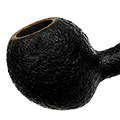 Somewhere between a Dublin and an Apple, the Acorn features a bowl that swells outwards toward the rim and then tapers dramatically inward as it approaches the heel, often going past the transition and shank to create a spur at the bottom of the bowl.
Somewhere between a Dublin and an Apple, the Acorn features a bowl that swells outwards toward the rim and then tapers dramatically inward as it approaches the heel, often going past the transition and shank to create a spur at the bottom of the bowl.
 A type of plastic used for the production of stems and often tenons and accent bands, it is prefered for its durability, workability and the fact that, unlike vulcanite, it will not oxidize.
A type of plastic used for the production of stems and often tenons and accent bands, it is prefered for its durability, workability and the fact that, unlike vulcanite, it will not oxidize.
 This material is sourced in various African countries and has a different composition than meerschaum mined in Turkey. Similar to Turkish meerschaum, though much harder and slightly heavier, it was often used by English pipe factories and can still be seen today. Bowls made from this material are fireproof, and are often stained with light colors. It's common for pipes made from African meerschaum to have the rims stained black by the factory.
This material is sourced in various African countries and has a different composition than meerschaum mined in Turkey. Similar to Turkish meerschaum, though much harder and slightly heavier, it was often used by English pipe factories and can still be seen today. Bowls made from this material are fireproof, and are often stained with light colors. It's common for pipes made from African meerschaum to have the rims stained black by the factory.
 This tobacco is dried naturally while being sheltered from sunlight. Burley is the only type of tobacco that is air-cured, so these terms can really be used interchangeably. Some tin descriptions may even note the presence of "air-cured leaf" assuming that the reader is aware that this means Burley. The drying process can be carried out on the whole plant or as individual leaves reach maturity over a period of one to two months. Air Curing results in less sugar, and Burley is less sweet than other tobaccos as a result. Burley also contains more oils and nicotine, producing a stronger tobacco. Burley comes in two strains, White and Dark, and can be processed to make Black Cavendish, Dark Fired Kentucky, and Perique.
This tobacco is dried naturally while being sheltered from sunlight. Burley is the only type of tobacco that is air-cured, so these terms can really be used interchangeably. Some tin descriptions may even note the presence of "air-cured leaf" assuming that the reader is aware that this means Burley. The drying process can be carried out on the whole plant or as individual leaves reach maturity over a period of one to two months. Air Curing results in less sugar, and Burley is less sweet than other tobaccos as a result. Burley also contains more oils and nicotine, producing a stronger tobacco. Burley comes in two strains, White and Dark, and can be processed to make Black Cavendish, Dark Fired Kentucky, and Perique.
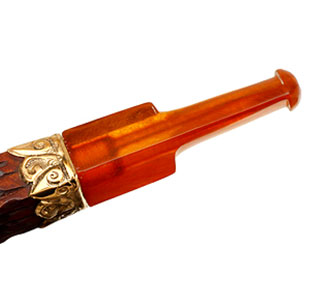 Amber is fossilized resin, a substance that flows just under the bark of trees. For use in pipe stems, Amber is usually shaped by hand; they are first immersed in oil and then heated, at which point they lose much of their brittle qualities. Amber stems can be easily scratched or chipped if not cared for properly. Though common on pipes of the 19th and early 20th century, amber stems are very rarely made today. There are a few ways to find out if your pipe has a genuine amber stem: Firstly, the tenons are usually made from bone with threads cut (like a screw). Secondly, amber holds a static charge. Remove a tiny fluff of a cotton ball or lint and place it on a desk. Rub the stem vigorously on a flannel shirt or pair of blue jeans to build up a static charge. Hold the stem over the fluff of cotton - genuine amber will pick it up while acrylic will not.
Amber is fossilized resin, a substance that flows just under the bark of trees. For use in pipe stems, Amber is usually shaped by hand; they are first immersed in oil and then heated, at which point they lose much of their brittle qualities. Amber stems can be easily scratched or chipped if not cared for properly. Though common on pipes of the 19th and early 20th century, amber stems are very rarely made today. There are a few ways to find out if your pipe has a genuine amber stem: Firstly, the tenons are usually made from bone with threads cut (like a screw). Secondly, amber holds a static charge. Remove a tiny fluff of a cotton ball or lint and place it on a desk. Rub the stem vigorously on a flannel shirt or pair of blue jeans to build up a static charge. Hold the stem over the fluff of cotton - genuine amber will pick it up while acrylic will not.
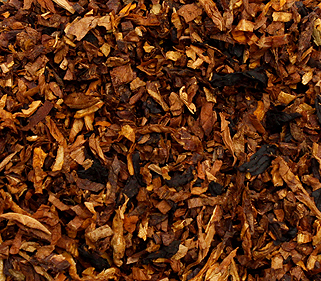 Traditionally, this tobacco blend consists of Virginia, Burley, and Oriental in varying proportions, often cased with aromatic flavors.
Traditionally, this tobacco blend consists of Virginia, Burley, and Oriental in varying proportions, often cased with aromatic flavors.
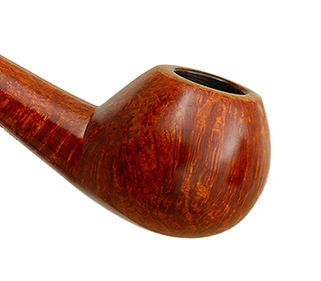 The Apple is a rounded version of the Billiard. The bowl is curved on both sides, much like the fruit it's named for, and usually has a round shank.
The Apple is a rounded version of the Billiard. The bowl is curved on both sides, much like the fruit it's named for, and usually has a round shank.
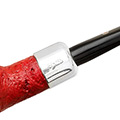 The "Army Mount" takes care of the issue of mortise/tenon joints being notoriously weak by reinforcing the mortise with a metal band or cap, and by using a stem that doesn't include a tenon, but instead tapers down to point where it can fit into the mortise. This removes the weak point on the stem and the taper reduces the surface area in contact with the mortise, thereby reducing the amount of grip, allowing the stem to be removed easily. When in use the mortise swells and grips the stem, so the stem won't simply fall out of the mount.
The "Army Mount" takes care of the issue of mortise/tenon joints being notoriously weak by reinforcing the mortise with a metal band or cap, and by using a stem that doesn't include a tenon, but instead tapers down to point where it can fit into the mortise. This removes the weak point on the stem and the taper reduces the surface area in contact with the mortise, thereby reducing the amount of grip, allowing the stem to be removed easily. When in use the mortise swells and grips the stem, so the stem won't simply fall out of the mount.
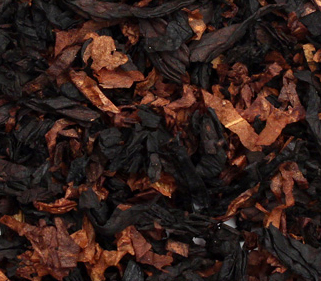 Like most blends, aromatics are lightly topped with natural flavorings to provide both added aroma and flavor when smoked. Unlike other blends; however, which utilize additional flavoring agents, such as whiskey, sugar water, and licorice to accentuate the flavors of the tobacco while leaving the natural aroma unfettered, aromatic is used to describe tobaccos which are heavily scented. Often these blends are more moist than non-aromatic blends.
Like most blends, aromatics are lightly topped with natural flavorings to provide both added aroma and flavor when smoked. Unlike other blends; however, which utilize additional flavoring agents, such as whiskey, sugar water, and licorice to accentuate the flavors of the tobacco while leaving the natural aroma unfettered, aromatic is used to describe tobaccos which are heavily scented. Often these blends are more moist than non-aromatic blends.
 Essentially a Prince with a larger, beefier, squatter bowl and a stem that can bend as much as 1/8 to 1/4.
Essentially a Prince with a larger, beefier, squatter bowl and a stem that can bend as much as 1/8 to 1/4.
 See Tomato.
See Tomato.
 Widely used for decorative purposes, a band of nickel, silver, gold, acrylic, or other materials can be found at the very end of the shank, just before the transition from shank to stem. Originally these were used to reinforce the mortise, or as aftermarket repairs to a broken mortise or shank.
Widely used for decorative purposes, a band of nickel, silver, gold, acrylic, or other materials can be found at the very end of the shank, just before the transition from shank to stem. Originally these were used to reinforce the mortise, or as aftermarket repairs to a broken mortise or shank.
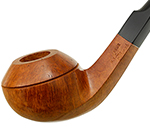 A "bent" is simply a catch-all term for a pipe bearing some degree of bend in the transition, shank, and/or stem. The bowl will vary in form, and most classic shapes can be found in both bent and straight variants.
A "bent" is simply a catch-all term for a pipe bearing some degree of bend in the transition, shank, and/or stem. The bowl will vary in form, and most classic shapes can be found in both bent and straight variants.
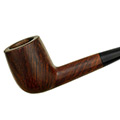 Possibly the most ubiquitous of the pipe shapes, the Billiard has a cylindrical bowl, a shank that is equal in length to the height of the bowl and can wear any stem type while still remaining a Billiard. Variants include the longer shanked Lumberman, Lovat, Canadian, and Liverpool, as well as the higher bowled Stack or Chimney.
Possibly the most ubiquitous of the pipe shapes, the Billiard has a cylindrical bowl, a shank that is equal in length to the height of the bowl and can wear any stem type while still remaining a Billiard. Variants include the longer shanked Lumberman, Lovat, Canadian, and Liverpool, as well as the higher bowled Stack or Chimney.
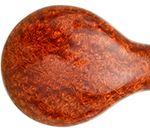 Birdseye is the grain of the burl as seen on its end and is so named because it looks like a grouping of small eyes. Depending on the orientation of the briar when it is cut, birdseye can appear on any part of the pipe.
Birdseye is the grain of the burl as seen on its end and is so named because it looks like a grouping of small eyes. Depending on the orientation of the briar when it is cut, birdseye can appear on any part of the pipe.
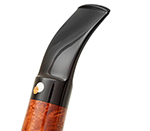 The bit is the part of the pipe that fits in the mouth. It generally refers to the entire stem, but most often describes the last inch of the pipe (which includes the button and slot).
The bit is the part of the pipe that fits in the mouth. It generally refers to the entire stem, but most often describes the last inch of the pipe (which includes the button and slot).
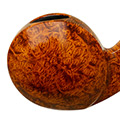 A modern shape with origins in the Danish school, and now popular amongst artisans far and wide, particularly those of Japan and the US. Though the interpretations, and re-interpretations, of this shape are many, the most basic form is a rounded, Apple-like bowl design with panels of (usually) differing size to either flank. Typically this shape is made with the briar oriented to show off birdseye grain on the panels.
A modern shape with origins in the Danish school, and now popular amongst artisans far and wide, particularly those of Japan and the US. Though the interpretations, and re-interpretations, of this shape are many, the most basic form is a rounded, Apple-like bowl design with panels of (usually) differing size to either flank. Typically this shape is made with the briar oriented to show off birdseye grain on the panels.
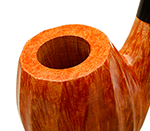 The bowl is the part of the pipe which holds the tobacco chamber.
The bowl is the part of the pipe which holds the tobacco chamber.
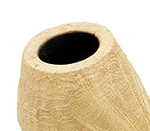 Bowl Coating is what many (though not all) pipemakers brush inside the tobacco chamber. It became a practice to help build cake and reduce the risk of burnout during the initial smokes - which can sometimes be considered harsh. The practice is highly debated among pipemakers and sometimes among customers, but it's simply a matter of personal opinion and aesthetic.
Bowl Coating is what many (though not all) pipemakers brush inside the tobacco chamber. It became a practice to help build cake and reduce the risk of burnout during the initial smokes - which can sometimes be considered harsh. The practice is highly debated among pipemakers and sometimes among customers, but it's simply a matter of personal opinion and aesthetic.
 A quite popular shape amongst Danish carvers, the Brandy features a wide base and tapers inward towards a more narrow chamber mouth. They traditionally sport a tapered stem and around 1/4 bend, though variations run the gamut of bend and stem type.
A quite popular shape amongst Danish carvers, the Brandy features a wide base and tapers inward towards a more narrow chamber mouth. They traditionally sport a tapered stem and around 1/4 bend, though variations run the gamut of bend and stem type.
 Briar is the primary wood from which tobacco pipes are made. The name is a corruption of the French word "bruyere," or heath tree, a low shrub found throughout Europe, though mainly around the Mediterranean. The true briar is only made out of the very hard, dry root of the mature shrub which may be anything up to 250 years old.
Briar is the primary wood from which tobacco pipes are made. The name is a corruption of the French word "bruyere," or heath tree, a low shrub found throughout Europe, though mainly around the Mediterranean. The true briar is only made out of the very hard, dry root of the mature shrub which may be anything up to 250 years old.
 The classic Bulldog shape has a slightly forward tilting bowl, beveled at its top portion and tapered toward its bottom, and a diamond shaped shank. Traditionally there are one or two small grooves, called bead-lines, cut around the bowl.
The classic Bulldog shape has a slightly forward tilting bowl, beveled at its top portion and tapered toward its bottom, and a diamond shaped shank. Traditionally there are one or two small grooves, called bead-lines, cut around the bowl.
 The burl is the dense mass of wood at the center of the root system of the Heath tree (erica arborea). It is from this burl that briar pipes are carved.
The burl is the dense mass of wood at the center of the root system of the Heath tree (erica arborea). It is from this burl that briar pipes are carved.
 Burley is an air-cured tobacco that contains almost no sugar; it burns slowly and is a cool smoke. It is used in many aromatic blends due to its ability to absorb flavorings. Burley has a very heavy dose of nicotine compared to other types of tobacco. Burley comes in two strains, White and Dark, and can be processed to make Black Cavendish, Dark Fired Kentucky, and Perique
Burley is an air-cured tobacco that contains almost no sugar; it burns slowly and is a cool smoke. It is used in many aromatic blends due to its ability to absorb flavorings. Burley has a very heavy dose of nicotine compared to other types of tobacco. Burley comes in two strains, White and Dark, and can be processed to make Black Cavendish, Dark Fired Kentucky, and Perique
 The raised lip at the very end of the stem is referred to as the "button" and often incorporates the slot, or opening at the end of the stem that serves as the terminus for the airway, where the smoke leaves the pipe and enters the mouth. Buttons and slots have quite a bit of attention paid to them by pipemakers, as this is the area that the smoker is most often in contact with. In fact, the button and slot are probably the most individualized area in terms of the makers signature, and while most will accept other makers emulating shapes, they are quite protective of the design of their button/slot.
The raised lip at the very end of the stem is referred to as the "button" and often incorporates the slot, or opening at the end of the stem that serves as the terminus for the airway, where the smoke leaves the pipe and enters the mouth. Buttons and slots have quite a bit of attention paid to them by pipemakers, as this is the area that the smoker is most often in contact with. In fact, the button and slot are probably the most individualized area in terms of the makers signature, and while most will accept other makers emulating shapes, they are quite protective of the design of their button/slot.
 Cake could refer to one of two things. For tobacco, Cake indicates a ribbon-cut blend that is pressed. Cakes differ from Plugs and Flakes which require the use of whole leaf. Pressed tobaccos do not require heat for their production. The density of these compacted cakes differ depending on the intended outcome. A crumble cake for instance is less dense than a traditional plug. For pipes, cake is the small layer of protective carbon allowed to form and remain in the bowl of a briar pipe. The cake can protect the briar from burning, though cake in a meerschaum will often lead to a cracked bowl as the temperature differential is too great.
Cake could refer to one of two things. For tobacco, Cake indicates a ribbon-cut blend that is pressed. Cakes differ from Plugs and Flakes which require the use of whole leaf. Pressed tobaccos do not require heat for their production. The density of these compacted cakes differ depending on the intended outcome. A crumble cake for instance is less dense than a traditional plug. For pipes, cake is the small layer of protective carbon allowed to form and remain in the bowl of a briar pipe. The cake can protect the briar from burning, though cake in a meerschaum will often lead to a cracked bowl as the temperature differential is too great.
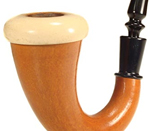 The Calabash shape is an interpretation of the classic Gourd Calabash. With a flared rim and tapered bowl these pipes are bent, sometimes to an extreme degree.
The Calabash shape is an interpretation of the classic Gourd Calabash. With a flared rim and tapered bowl these pipes are bent, sometimes to an extreme degree.
 This pipe is again similar to the Billiard but has a long oval shaped shank and a tapered bit.
This pipe is again similar to the Billiard but has a long oval shaped shank and a tapered bit.
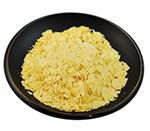 This wax is made from the leaves of the palm Copernicia prunifera and is used to give pipes their shine. Due to the rather hard nature of the material, it takes a polish extremely well and does not dull as fast as waxes that have a lower melting point. Carnuba wax is also very common in the food industry to coat little shiny, hard candies to keep them from melting in your hands.
This wax is made from the leaves of the palm Copernicia prunifera and is used to give pipes their shine. Due to the rather hard nature of the material, it takes a polish extremely well and does not dull as fast as waxes that have a lower melting point. Carnuba wax is also very common in the food industry to coat little shiny, hard candies to keep them from melting in your hands.
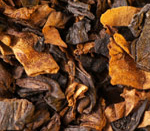 Casing is a broad treatment that is added to raw tobacco varieties before they are used in blends. Toppings, on the other hand, are flavorings added to make specific blends from those tobaccos which are already cased. Most tobaccos are cased to some extent, be it a light sugar topping or something more aromatic.
Casing is a broad treatment that is added to raw tobacco varieties before they are used in blends. Toppings, on the other hand, are flavorings added to make specific blends from those tobaccos which are already cased. Most tobaccos are cased to some extent, be it a light sugar topping or something more aromatic.
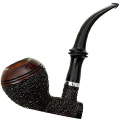 An old and distinctive shape built around providing a moisture-trap where condensation can collect out of the smoke-stream. Bowl shapes may vary, but the Cavalier is easily recognized by its deeply-bent configuration and a shank that extends past and underneath the bowl itself. This portion of the shank is traditionally drilled all the way through, fitted with a removable cap at the end, and serves as the moisture-trap.
An old and distinctive shape built around providing a moisture-trap where condensation can collect out of the smoke-stream. Bowl shapes may vary, but the Cavalier is easily recognized by its deeply-bent configuration and a shank that extends past and underneath the bowl itself. This portion of the shank is traditionally drilled all the way through, fitted with a removable cap at the end, and serves as the moisture-trap.
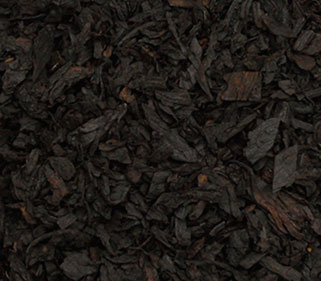 Cavendish is a method of treating tobacco, not a type of tobacco. Cavendish is mainly produced from Virginia and Burley tobaccos, and is created by steaming the tobacco and then storing it under pressure for several days (or weeks) to allow it to ferment.
Cavendish is a method of treating tobacco, not a type of tobacco. Cavendish is mainly produced from Virginia and Burley tobaccos, and is created by steaming the tobacco and then storing it under pressure for several days (or weeks) to allow it to ferment.
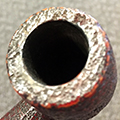 While often conflated with "bowl," the hollow inside of the pipe, in which the tobacco sits, is correctly known as the "chamber". It is connected at the bottom (or heel) to the draft hole and airway and is traditionally bored out before rough shaping of the stummel begins.
While often conflated with "bowl," the hollow inside of the pipe, in which the tobacco sits, is correctly known as the "chamber". It is connected at the bottom (or heel) to the draft hole and airway and is traditionally bored out before rough shaping of the stummel begins.
 This is the wood of the Cherry tree. At one time, this was a popular wood for making pipes, however, now only a few companies produce cherry wood pipes.
This is the wood of the Cherry tree. At one time, this was a popular wood for making pipes, however, now only a few companies produce cherry wood pipes.
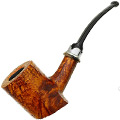 Essentially a Poker shape, but with the base sloped so that the bowl cants forward when sitting. The shank can be straight, like the poker, or bent, though generally the stem is presented as level horizontally, so if the shank bends, the stem bends in the opposite direction.
Essentially a Poker shape, but with the base sloped so that the bowl cants forward when sitting. The shank can be straight, like the poker, or bent, though generally the stem is presented as level horizontally, so if the shank bends, the stem bends in the opposite direction.
 While most pipes are identified by their bowl shape the Churchwarden is easily recognized by its extra-long stem. The style is often paired with a smaller than average bowl size.
While most pipes are identified by their bowl shape the Churchwarden is easily recognized by its extra-long stem. The style is often paired with a smaller than average bowl size.
 This is a pipe made from Clay. There are two main varieties: hand-rolled and slip-cast. Hand-rolled are exactly that. The clay is rolled by hand into the shape of the pipe, and a wire is inserted into it before firing to create a draw-hole. A slip-cast pipe is one made with a more liquid clay poured into a mold. In general, hand-rolled clays are held in higher regard.
This is a pipe made from Clay. There are two main varieties: hand-rolled and slip-cast. Hand-rolled are exactly that. The clay is rolled by hand into the shape of the pipe, and a wire is inserted into it before firing to create a draw-hole. A slip-cast pipe is one made with a more liquid clay poured into a mold. In general, hand-rolled clays are held in higher regard.
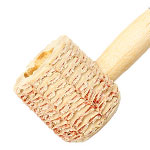 A corncob pipe is made from the interior cob of an ear of corn. The cobs are dried then hollowed out to make the bowl and fitted with either a simple reed stem or a wooden shank with an acrylic stem. Though inexpensive and enjoyable to smoke, cob pipes typically do not have anything like the lifespan of a briar or meerschaum pipe.
A corncob pipe is made from the interior cob of an ear of corn. The cobs are dried then hollowed out to make the bowl and fitted with either a simple reed stem or a wooden shank with an acrylic stem. Though inexpensive and enjoyable to smoke, cob pipes typically do not have anything like the lifespan of a briar or meerschaum pipe.
 Cube is a particular cut of tobacco in which the leaf is cut into small roughly square chunks. This is a popular cut for Burley tobacco.
Cube is a particular cut of tobacco in which the leaf is cut into small roughly square chunks. This is a popular cut for Burley tobacco.
 A sulphur-hardened rubber material created much the same way as Ebonite and Vulcanite, only it often possesses red and brown pigments added for a brindled aesthetic. It's soft like Vulcanite, yet far more flexible than lucite or acrylic. The name cumberland itself stems from Dunhill's Cumberland finish, which was the first to incorporate this particular medium in its stems.
A sulphur-hardened rubber material created much the same way as Ebonite and Vulcanite, only it often possesses red and brown pigments added for a brindled aesthetic. It's soft like Vulcanite, yet far more flexible than lucite or acrylic. The name cumberland itself stems from Dunhill's Cumberland finish, which was the first to incorporate this particular medium in its stems.
 Curing is the process of drying newly harvested tobacco. Curing takes many forms, such as air curing, flue curing, fire curing, etc.
Curing is the process of drying newly harvested tobacco. Curing takes many forms, such as air curing, flue curing, fire curing, etc.
 A shape dating back to the clay tavern pipes of old, the Cutty features a forward canted bowl and usually a 1/8 bend. Unlike its cousin the Belge, it usually features a spur or foot just under the base of the bowl.
A shape dating back to the clay tavern pipes of old, the Cutty features a forward canted bowl and usually a 1/8 bend. Unlike its cousin the Belge, it usually features a spur or foot just under the base of the bowl.
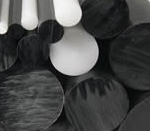 Delrin is an outstanding general purpose mechanical plastic, and is popular for its versatility in industry today. It is used by some pipe makers for tenons.
Delrin is an outstanding general purpose mechanical plastic, and is popular for its versatility in industry today. It is used by some pipe makers for tenons.
 This is a practice consisting of lighting your pipe and smoking half a bowl then putting it down to re-light later to create a new flavor experience.
This is a practice consisting of lighting your pipe and smoking half a bowl then putting it down to re-light later to create a new flavor experience.
 Variation of the Author shape with an oval, rather than circular shank cross-section. Generally less common than the Author itself.
Variation of the Author shape with an oval, rather than circular shank cross-section. Generally less common than the Author itself.
 Dottle is the unburned tobacco left in the heel of a pipe after smoking.
Dottle is the unburned tobacco left in the heel of a pipe after smoking.
 The draft hole refers to the opening of the airway as it meets the bottom of the chamber. In a correctly drilled pipe, the draft hole should be centered along the bottom-back of the chamber.
The draft hole refers to the opening of the airway as it meets the bottom of the chamber. In a correctly drilled pipe, the draft hole should be centered along the bottom-back of the chamber.
 A pipe having a bowl that tapers downward from the (typically flat) rim, and any kind of shank and stem, bent or straight. Dublins often had a tapered chamber as well, which allowed the flavors of tobacco to build as you smoke which some find desirable. The chamber is also (usually) tapered to keep the briar thickness even all around the tobacco chamber.
A pipe having a bowl that tapers downward from the (typically flat) rim, and any kind of shank and stem, bent or straight. Dublins often had a tapered chamber as well, which allowed the flavors of tobacco to build as you smoke which some find desirable. The chamber is also (usually) tapered to keep the briar thickness even all around the tobacco chamber.
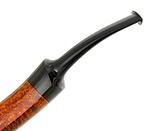 Ebonite and Vulcanite are essentially the same material: vulcanized rubber. The process of vulcanization converts natural rubber into a harder and more durable material. Ebonite was simply a brand name obtained by Charles Goodyear for the vulcanized rubber material. The addition of sulfur is what leads to this material oxidizing (turning yellowish or brownish - which can easily be polished away). There are a variety of industrial uses for vulcanite (sheets and rods), which is what pipe makers use to craft a 'hand cut' stem. Vulcanite can also be a liquid cast. "Pre-form" stems are made from injecting liquid vulcanite into a mold, resulting in a 'cast' stem. Many pipe makers use high-quality vulcanized rods due to the microscopic exclusion of bubbles and, therefore, much slower oxidation. Ebonite and Vulcanite are used among pipe makers and factories interchangeably for the same product.
Ebonite and Vulcanite are essentially the same material: vulcanized rubber. The process of vulcanization converts natural rubber into a harder and more durable material. Ebonite was simply a brand name obtained by Charles Goodyear for the vulcanized rubber material. The addition of sulfur is what leads to this material oxidizing (turning yellowish or brownish - which can easily be polished away). There are a variety of industrial uses for vulcanite (sheets and rods), which is what pipe makers use to craft a 'hand cut' stem. Vulcanite can also be a liquid cast. "Pre-form" stems are made from injecting liquid vulcanite into a mold, resulting in a 'cast' stem. Many pipe makers use high-quality vulcanized rods due to the microscopic exclusion of bubbles and, therefore, much slower oxidation. Ebonite and Vulcanite are used among pipe makers and factories interchangeably for the same product.
 An English blend is usually one which has as its base a Virginia tobacco, to which are added Oriental tobaccos, Latakia, and perhaps some Perique. In common usage, "English" also denotes a tobacco that is free from artificial flavoring — though natural casings like various spirits or floral compounds may still be present.
An English blend is usually one which has as its base a Virginia tobacco, to which are added Oriental tobaccos, Latakia, and perhaps some Perique. In common usage, "English" also denotes a tobacco that is free from artificial flavoring — though natural casings like various spirits or floral compounds may still be present.
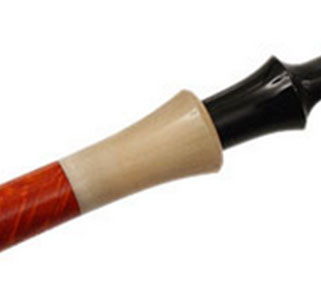 An accent at the end of the shank that is one solid piece of material or combination of materials bonded together. Unlike bands or a spigot/army mount, these do not surround the mortise, but rather have the mortise drilled into the accent material itself.
An accent at the end of the shank that is one solid piece of material or combination of materials bonded together. Unlike bands or a spigot/army mount, these do not surround the mortise, but rather have the mortise drilled into the accent material itself.
 Fill refers to the area of a pipe that has a natural imperfection that is filled with a different material. Many pipes have fills, and most of those are simply a way to make a pipe bowl or shank not have the appearance of a hole or natural flaw. Briar, being a natural, underground material can sometimes have natural sandpits or tiny cracks, neither of which would affect smoking in most cases. Most fills are done by taking a tool to carve out the flaw in briar, then filling it with a sort of wood putty. A pipe that is free of natural flaws is generally more expensive.
Fill refers to the area of a pipe that has a natural imperfection that is filled with a different material. Many pipes have fills, and most of those are simply a way to make a pipe bowl or shank not have the appearance of a hole or natural flaw. Briar, being a natural, underground material can sometimes have natural sandpits or tiny cracks, neither of which would affect smoking in most cases. Most fills are done by taking a tool to carve out the flaw in briar, then filling it with a sort of wood putty. A pipe that is free of natural flaws is generally more expensive.
 Finish refers to the techniques, stains, and waxes applied to the exterior surface of a pipe. Common finish terms are: smooth, rusticated, sandblasted, carved, and natural.
Finish refers to the techniques, stains, and waxes applied to the exterior surface of a pipe. Common finish terms are: smooth, rusticated, sandblasted, carved, and natural.
 Kentucky fire-cured tobacco is Stalk-Cured under controlled humidity in barns with a series of gentle smoldering hardwood fires throughout. Considerable care is taken to achieve proper yellowing; firing requires considerable skill so as not to "burn" the tobacco or cause tobacco rot through too high humidity. The resulting tobacco possesses a powerful smoky note reminiscent of smoked meats and provides a rich "smoky & sweet note" in tobacco products. Fire-Cured Tobacco is much less pungent than Latakia, a sun-cured & smoke-cured tobacco produced in the mid-east with a unique fuel source.
Kentucky fire-cured tobacco is Stalk-Cured under controlled humidity in barns with a series of gentle smoldering hardwood fires throughout. Considerable care is taken to achieve proper yellowing; firing requires considerable skill so as not to "burn" the tobacco or cause tobacco rot through too high humidity. The resulting tobacco possesses a powerful smoky note reminiscent of smoked meats and provides a rich "smoky & sweet note" in tobacco products. Fire-Cured Tobacco is much less pungent than Latakia, a sun-cured & smoke-cured tobacco produced in the mid-east with a unique fuel source.
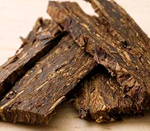 Flake is a type of tobacco produced by being compacted under great pressure for days at a time, producing cakes of tobacco which when taken from the press are guillotined into thin slices.
Flake is a type of tobacco produced by being compacted under great pressure for days at a time, producing cakes of tobacco which when taken from the press are guillotined into thin slices.
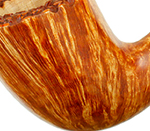 Flame grain is the name applied to grain on a pipe which is almost 'straight grain' but displays some variation in the thickness of the grain, resulting in a "tiger's eye" type of look.
Flame grain is the name applied to grain on a pipe which is almost 'straight grain' but displays some variation in the thickness of the grain, resulting in a "tiger's eye" type of look.
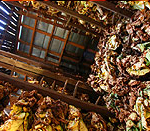 Flue-cured tobacco is lemon, orange, or mahogany in color, with a high sugar content and a medium-to-high nicotine content. Flue curing requires a closed building equipped with a system of ventilation and a source of heat. When heat and humidity are controlled, leaf color changes, moisture is quickly removed, and the leaf and stems dry.
Flue-cured tobacco is lemon, orange, or mahogany in color, with a high sugar content and a medium-to-high nicotine content. Flue curing requires a closed building equipped with a system of ventilation and a source of heat. When heat and humidity are controlled, leaf color changes, moisture is quickly removed, and the leaf and stems dry.
 A foot refers to the bottom of the bowl's fore just before it reaches the underside of the pipe. In some contexts, it can also refer to a cylindrical spur positioned along the base.
A foot refers to the bottom of the bowl's fore just before it reaches the underside of the pipe. In some contexts, it can also refer to a cylindrical spur positioned along the base.
 Generally speaking, a Freehand pipe could be any shape that the bowl and/or shank could not be turned on a lathe. There are a great deal of shapes which fall into this category, though 'Freehand' also refers to a pipe in which the carver shapes first and drills secondly. While most classic shapes have narrower rules for design, Freehand shapes can take advantage of grain and artistic whimsy and creativity. Olifant, Blowfish, Ramses, Elephant's Foot, Horn, and Fig are only a some examples. Most pipes made today outside of a factory could be considered Freehand designs, which is why many of their names have become common designs of their own.
Generally speaking, a Freehand pipe could be any shape that the bowl and/or shank could not be turned on a lathe. There are a great deal of shapes which fall into this category, though 'Freehand' also refers to a pipe in which the carver shapes first and drills secondly. While most classic shapes have narrower rules for design, Freehand shapes can take advantage of grain and artistic whimsy and creativity. Olifant, Blowfish, Ramses, Elephant's Foot, Horn, and Fig are only a some examples. Most pipes made today outside of a factory could be considered Freehand designs, which is why many of their names have become common designs of their own.
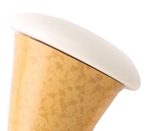 Gourd refers to a Calabash actually made from that gourd, to distinguish it from a briar pipe carved in the general shape of a Calabash. This is a South African gourd, similar to a squash, which is grown specifically for use in pipes. The shape is determined as the gourd grows by placing small blocks under the stem, forcing it into a gentle curve. The mature gourd is cut and dried, then fitted with a cork gasket to receive a meerschaum bowl. The finished pipe offers one of the coolest, driest smokes available.
Gourd refers to a Calabash actually made from that gourd, to distinguish it from a briar pipe carved in the general shape of a Calabash. This is a South African gourd, similar to a squash, which is grown specifically for use in pipes. The shape is determined as the gourd grows by placing small blocks under the stem, forcing it into a gentle curve. The mature gourd is cut and dried, then fitted with a cork gasket to receive a meerschaum bowl. The finished pipe offers one of the coolest, driest smokes available.
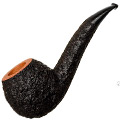 A pipe-shape that originated at Castello, the standard Hawkbill is defined by a rounded bowl, an upward-angled transition, and a long shank that follows a gradual, arching curve, tipped by a short stem positioned roughly even in height with the rim. Bowl-forms can vary quite a bit, but it's the aquiline curve of the long shank that gives this shape its name. Luigi Radice, who was an artisan at Castello when this shape first appeared, has sometimes been mistaken for its inventor. He has stated otherwise to clear the record, and admits that he cannot recall who at Castello first came up with it.
A pipe-shape that originated at Castello, the standard Hawkbill is defined by a rounded bowl, an upward-angled transition, and a long shank that follows a gradual, arching curve, tipped by a short stem positioned roughly even in height with the rim. Bowl-forms can vary quite a bit, but it's the aquiline curve of the long shank that gives this shape its name. Luigi Radice, who was an artisan at Castello when this shape first appeared, has sometimes been mistaken for its inventor. He has stated otherwise to clear the record, and admits that he cannot recall who at Castello first came up with it.
 Erica Arborea, the heath tree is the source of briar burls, from which briar pipes are carved. It grows best in the arid soils of the Mediterranean and Asia Minor.
Erica Arborea, the heath tree is the source of briar burls, from which briar pipes are carved. It grows best in the arid soils of the Mediterranean and Asia Minor.
 The heel is the bottom of the chamber.
The heel is the bottom of the chamber.
 Though varying greatly from maker to maker, the Horn shape features a smooth taper from rim to bit. The bowl is almost always set at a deep forward cant, and the transition is normally fluid and sweeping. They normally feature some degree of bend, and a variety of stem styles can be employed.
Though varying greatly from maker to maker, the Horn shape features a smooth taper from rim to bit. The bowl is almost always set at a deep forward cant, and the transition is normally fluid and sweeping. They normally feature some degree of bend, and a variety of stem styles can be employed.
 Although one generally thinks about humidors as a humidified box for the storage of cigars, once upon a time it also referred to what we think of now as a jar. For pipe tobacco it's ideally cheap and air-tight (try mason jars) - one places fresh tobacco in it and, once sealed, it will maintain the tobacco in a smokable consistency indefinitely.
A major alternate use of a humidor is the "re-moistening" of dried out tobacco. For this action one adds a source of moisture to the tobacco in the humidor before sealing.
Although one generally thinks about humidors as a humidified box for the storage of cigars, once upon a time it also referred to what we think of now as a jar. For pipe tobacco it's ideally cheap and air-tight (try mason jars) - one places fresh tobacco in it and, once sealed, it will maintain the tobacco in a smokable consistency indefinitely.
A major alternate use of a humidor is the "re-moistening" of dried out tobacco. For this action one adds a source of moisture to the tobacco in the humidor before sealing.
 See Oom Paul
See Oom Paul
 Latakia is a city in Syria, for which a particular Oriental varietal tobacco is named. Latakia is the result of a curing process involving fire curing the leaves over controlled fires of aromatic woods and fragrant herbs.
It is probably the most well known spice tobacco and is mainly grown in Cyprus and northern Syria. After the leaves are harvested and dried, they are hung in tightly closed barns and smoke-cured. Small smouldering fires of oak and pine fill the barn with smoke and cover the leaves with smoke particles.
Latakia is a city in Syria, for which a particular Oriental varietal tobacco is named. Latakia is the result of a curing process involving fire curing the leaves over controlled fires of aromatic woods and fragrant herbs.
It is probably the most well known spice tobacco and is mainly grown in Cyprus and northern Syria. After the leaves are harvested and dried, they are hung in tightly closed barns and smoke-cured. Small smouldering fires of oak and pine fill the barn with smoke and cover the leaves with smoke particles.
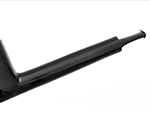 A Lovat is a Billiard-shaped pipe with a long, round shank and a saddle bit.
A Lovat is a Billiard-shaped pipe with a long, round shank and a saddle bit.
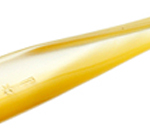 Lucite is the trade name for a very hard and durable plastic. It is commonly used as a material for pipe stems on both handmade and mass-produced pipes. Many makers favor lucite because of its durability; however, many consider it not as comfortable in the mouth as vulcanite. It is particularly favored over vulcanite (which is softer) among Italian pipe craftsmen.
Lucite is the trade name for a very hard and durable plastic. It is commonly used as a material for pipe stems on both handmade and mass-produced pipes. Many makers favor lucite because of its durability; however, many consider it not as comfortable in the mouth as vulcanite. It is particularly favored over vulcanite (which is softer) among Italian pipe craftsmen.
 Meerschaum (a.k.a. sepiolite) is a soft, white mineral valued for pipemaking on account of its ease of carving when wet, the exceptionally pure flavor qualities it produces from a smoke, and its, for all practical purposes, immunity to burn-out. The name comes from the German word for "seafoam", which was applied to this material originally due to its appearance, its often very light density, and its having sometimes been found floating on the Black Sea. This material can actually vary widely in density, and while most meerschaum is indeed very light, you may occasionally come across examples that are even denser than briar by a very noticeable degree. When the term "meerschaum" is used alone, it is usually to refer to Turkish meerschaum, which originates from the mines of the Eskisehir region. See also: African Meerschaum.
Meerschaum (a.k.a. sepiolite) is a soft, white mineral valued for pipemaking on account of its ease of carving when wet, the exceptionally pure flavor qualities it produces from a smoke, and its, for all practical purposes, immunity to burn-out. The name comes from the German word for "seafoam", which was applied to this material originally due to its appearance, its often very light density, and its having sometimes been found floating on the Black Sea. This material can actually vary widely in density, and while most meerschaum is indeed very light, you may occasionally come across examples that are even denser than briar by a very noticeable degree. When the term "meerschaum" is used alone, it is usually to refer to Turkish meerschaum, which originates from the mines of the Eskisehir region. See also: African Meerschaum.
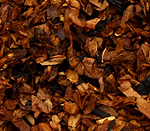 A mixture is a blend of different tobaccos, each chosen for their particular characteristics, assembled by a blender to achieve a particular tobacco taste or experience.
A mixture is a blend of different tobaccos, each chosen for their particular characteristics, assembled by a blender to achieve a particular tobacco taste or experience.
 A hole in the end of the shank that connects to the stem via the tenon. Put together, the tenon (male) and mortise (female) form a joint, which is typically the weakest part of the pipe. Hence care must be taken when removing the tenon from the mortise, especially when the pipe is hot and the mortise has expanded.
A hole in the end of the shank that connects to the stem via the tenon. Put together, the tenon (male) and mortise (female) form a joint, which is typically the weakest part of the pipe. Hence care must be taken when removing the tenon from the mortise, especially when the pipe is hot and the mortise has expanded.
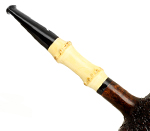 The mouthpiece is all of the pipe that is not, technically, the bowl. It is made up of the lip, the draft hole, and the tenon.
The mouthpiece is all of the pipe that is not, technically, the bowl. It is made up of the lip, the draft hole, and the tenon.
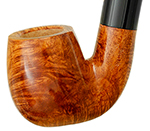 The Oom-Paul (Afrikaans for Uncle Paul) is a pipe shape named after Paul Kruger, President of the ZAR (Zuid-Afrikaansche Republiek) during the late 1800's. It is defined as a fully (or at least very deeply) bent shape, typically with a cylindrical, Billiard-like bowl and a shank-end that is even in height with the rim. Generally this shape is noted for producing a very easy balance for leaving clenched between the teeth, while still providing a bowl with a deep chamber. It is also sometimes called a Hungarian.
The Oom-Paul (Afrikaans for Uncle Paul) is a pipe shape named after Paul Kruger, President of the ZAR (Zuid-Afrikaansche Republiek) during the late 1800's. It is defined as a fully (or at least very deeply) bent shape, typically with a cylindrical, Billiard-like bowl and a shank-end that is even in height with the rim. Generally this shape is noted for producing a very easy balance for leaving clenched between the teeth, while still providing a bowl with a deep chamber. It is also sometimes called a Hungarian.
 A Billiard in profile, the opera pipe has been flattened so that it can fit comfortably in the breast pocket of a jacket without ruining the lines of the suit. Despite their portability the Opera pipe has dropped in popularity as the oval bowl can be known to promote an uneven burn.
A Billiard in profile, the opera pipe has been flattened so that it can fit comfortably in the breast pocket of a jacket without ruining the lines of the suit. Despite their portability the Opera pipe has dropped in popularity as the oval bowl can be known to promote an uneven burn.
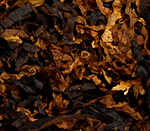 A generic term, Oriental, or Turkish, is a sun cured spice tobacco known for its nutty, somewhat "sweet and sour" flavor. It's a main component in English blends, along with Latakia (which is itself an Oriental that's been flavored with smoke). This tobacco derives its name from the area in which it's grown: the Eastern Mediterranean. Each of the varietals, in fact, are named after the towns or regions they come from. Thus, Yenidje and Smyrna are Greek, Samsun and Izmir are Turkish, Drama is Macedonian, and Xanthe is from the region of Thrace, which is mostly in Greece. For all intents and purposes this is all one region, united for many years under Turkish rule (hence the interchangeable terms "Oriental" and "Turkish".) Oriental tobacco plants characteristically have a great deal of small leaves. The finished product ranges in color from yellow to brown, and possesses a pronounced and unique natural aroma.
A generic term, Oriental, or Turkish, is a sun cured spice tobacco known for its nutty, somewhat "sweet and sour" flavor. It's a main component in English blends, along with Latakia (which is itself an Oriental that's been flavored with smoke). This tobacco derives its name from the area in which it's grown: the Eastern Mediterranean. Each of the varietals, in fact, are named after the towns or regions they come from. Thus, Yenidje and Smyrna are Greek, Samsun and Izmir are Turkish, Drama is Macedonian, and Xanthe is from the region of Thrace, which is mostly in Greece. For all intents and purposes this is all one region, united for many years under Turkish rule (hence the interchangeable terms "Oriental" and "Turkish".) Oriental tobacco plants characteristically have a great deal of small leaves. The finished product ranges in color from yellow to brown, and possesses a pronounced and unique natural aroma.
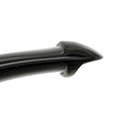 First patented by Peterson in 1898, the P-Lip is a variant button/slot setup that uses a hole positioned at the top of the stem, rather than the traditional "fishtail" which has a slot at the very end. The stem was designed by Charles Peterson to try and curb "tongue bite" by pushing the smoke to the roof of the mouth rather than the tip of the tongue.
First patented by Peterson in 1898, the P-Lip is a variant button/slot setup that uses a hole positioned at the top of the stem, rather than the traditional "fishtail" which has a slot at the very end. The stem was designed by Charles Peterson to try and curb "tongue bite" by pushing the smoke to the roof of the mouth rather than the tip of the tongue.
 Most commonly and originally a simple flat surface shaped along the sides of the bowl, or the underside of the bowl and/or shank (the latter usually to allow a pipe to sit upright). Originally panels along the front, rear, or sides of a bowl were introduced by factories to create an aesthetically pleasing pipe from a standard shape (such as the Billiard) that came out of the shaping machine with an unacceptable natural flaw, such as a large sandpit, on the bowl's surface. Modern artisanal pipemaking later turned to using panels as a means of framing particularly choice grain, along the way introducing more complex types of panels — convex, concave, asymmetrical, etc. The Blowfish is a common example of modern pipe design where these more complex panel styles are a standard shape feature.
Most commonly and originally a simple flat surface shaped along the sides of the bowl, or the underside of the bowl and/or shank (the latter usually to allow a pipe to sit upright). Originally panels along the front, rear, or sides of a bowl were introduced by factories to create an aesthetically pleasing pipe from a standard shape (such as the Billiard) that came out of the shaping machine with an unacceptable natural flaw, such as a large sandpit, on the bowl's surface. Modern artisanal pipemaking later turned to using panels as a means of framing particularly choice grain, along the way introducing more complex types of panels — convex, concave, asymmetrical, etc. The Blowfish is a common example of modern pipe design where these more complex panel styles are a standard shape feature.
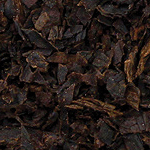 Perique is a spice tobacco produced from Burley which has been subjected to extreme pressure for one year in wood barrels. The leaf essentially marinates and ferments in its own juices. Perique is typically used in Virginia blends. It has a dark, oily appearance, and a taste of pepper and figs. It's flavor is very strong, so it isn't usually found in high percentages in a blend. It can be smoked straight, but isn't intended to be. Its role as a complement to VA's is not just because of its flavor. Being highly acidic, it tends to alleviate alkaline tongue bite, which is so often a problem with Virginia tobacco. The process by which this tobacco is produced pre-dates Columbus. The Choctaw Indians of (what would later be) Louisiana would make it by pressing it into hollow logs with a long pole, and securing it with weights. After the Acadians (Cajuns) settled the area in the mid-1700's, the Choctaws taught this process to a French colonist by the name of Pierre Chenet.
Perique is a spice tobacco produced from Burley which has been subjected to extreme pressure for one year in wood barrels. The leaf essentially marinates and ferments in its own juices. Perique is typically used in Virginia blends. It has a dark, oily appearance, and a taste of pepper and figs. It's flavor is very strong, so it isn't usually found in high percentages in a blend. It can be smoked straight, but isn't intended to be. Its role as a complement to VA's is not just because of its flavor. Being highly acidic, it tends to alleviate alkaline tongue bite, which is so often a problem with Virginia tobacco. The process by which this tobacco is produced pre-dates Columbus. The Choctaw Indians of (what would later be) Louisiana would make it by pressing it into hollow logs with a long pole, and securing it with weights. After the Acadians (Cajuns) settled the area in the mid-1700's, the Choctaws taught this process to a French colonist by the name of Pierre Chenet.
 The Pickaxe is a Acorn-esque freehand shape featuring a panelled, triangular bowl, with the base normally coming to a sharp point.
The Pickaxe is a Acorn-esque freehand shape featuring a panelled, triangular bowl, with the base normally coming to a sharp point.
 A pipe is a tube made from clay, wood, etc. which has a bowl at one end for holding lit tobacco, the smoke of which is drawn through the tube towards the smoker at the other end.
A pipe is a tube made from clay, wood, etc. which has a bowl at one end for holding lit tobacco, the smoke of which is drawn through the tube towards the smoker at the other end.
 Plugs differ from cakes in that they are comprised of whole leaf, whereas Cakes utilize cut tobacco. Conditioned with water, the blend is slowly pressed in large steam presses for several days to meld the rich and varied aromas. Plugs, when sliced, produce Flakes, yet the plug form allows the smoker to cut and rub it out to their own preference.
Plugs differ from cakes in that they are comprised of whole leaf, whereas Cakes utilize cut tobacco. Conditioned with water, the blend is slowly pressed in large steam presses for several days to meld the rich and varied aromas. Plugs, when sliced, produce Flakes, yet the plug form allows the smoker to cut and rub it out to their own preference.
 A straight pipe with a cylindrical bowl and a flat bottom; the shank usually connects to the bowl at an abrupt angle, without any sort of contouring or smoothing. Straight Pokers with round shanks look like judge's gavels. Pokers with upwards slanting shanks may be called Cherrywoods.
A straight pipe with a cylindrical bowl and a flat bottom; the shank usually connects to the bowl at an abrupt angle, without any sort of contouring or smoothing. Straight Pokers with round shanks look like judge's gavels. Pokers with upwards slanting shanks may be called Cherrywoods.
 A classic shape-chart design similar in profile to the Billiard, just with a shorter bowl and a typically broader chamber.
A classic shape-chart design similar in profile to the Billiard, just with a shorter bowl and a typically broader chamber.
 The Prince has a squat rounded bowl that has a short, round shank paired with a long stem. The stem is usually only bent down very slightly. Sometimes called "Prince of Wales", or "Prince Regent", this shape was designed for Prince Albert (Edward VII) of England.
The Prince has a squat rounded bowl that has a short, round shank paired with a long stem. The stem is usually only bent down very slightly. Sometimes called "Prince of Wales", or "Prince Regent", this shape was designed for Prince Albert (Edward VII) of England.
 A rack is a storage place for your pipes. To best enjoy pipe smoking one needs several pipes to accommodate one's moods and activities.
A rack is a storage place for your pipes. To best enjoy pipe smoking one needs several pipes to accommodate one's moods and activities.
 A reamer is a tool for smoothing out the cake and trimming it down to a desired size. Reamers come in a variety of shapes and functionalities.
A reamer is a tool for smoothing out the cake and trimming it down to a desired size. Reamers come in a variety of shapes and functionalities.
 This is tobacco cut into long, thin ribbons, though not as long or as fine as shag.
This is tobacco cut into long, thin ribbons, though not as long or as fine as shag.
 A rotation is a system by which a pipe smoker keeps his/her pipes in good working order by varying when each pipe is smoked. Most smokers own more than one pipe, their selection of pipes can be said to be their rotation. It can also be said that the particular order in which the pipes are smoked is the rotation. However it is used, having a rotation allows you to give each pipe the opportunity to rest for a period between smokes. How long your pipes need to rest is a hotly debated topic, but it seems that the minimum time acceptable is around 48 hours, so to build a decent rotation of pipes, you will need to purchase (number of pipes you smoke in a day) x 2, to allow a two day rest between pipes.
A rotation is a system by which a pipe smoker keeps his/her pipes in good working order by varying when each pipe is smoked. Most smokers own more than one pipe, their selection of pipes can be said to be their rotation. It can also be said that the particular order in which the pipes are smoked is the rotation. However it is used, having a rotation allows you to give each pipe the opportunity to rest for a period between smokes. How long your pipes need to rest is a hotly debated topic, but it seems that the minimum time acceptable is around 48 hours, so to build a decent rotation of pipes, you will need to purchase (number of pipes you smoke in a day) x 2, to allow a two day rest between pipes.
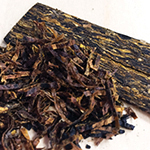 This is a flake tobacco that has been broken up before smoking to form a ribbon of sorts.
This is a flake tobacco that has been broken up before smoking to form a ribbon of sorts.
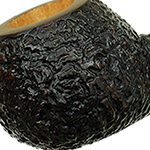 Rustication is a finishing technique in which the outside surface is decoratively roughed up.
Rustication is a finishing technique in which the outside surface is decoratively roughed up.
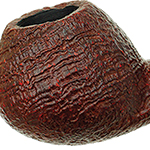 Sandblasting is a finishing technique in which the softer wood in the grain is blasted away, which leaves the harder wood in rings to stand out.
Sandblasting is a finishing technique in which the softer wood in the grain is blasted away, which leaves the harder wood in rings to stand out.
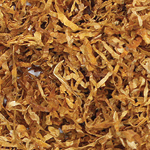 Shag is tobacco which has been shredded very finely. It is renowned as the type of preference for Sherlock Holmes; at that time, however, shag was considered an inferior grade.
Shag is tobacco which has been shredded very finely. It is renowned as the type of preference for Sherlock Holmes; at that time, however, shag was considered an inferior grade.
 The shank is the part of the pipe that joins the bowl and the stem. Usually the shank is carved from the same material as the bowl.
The shank is the part of the pipe that joins the bowl and the stem. Usually the shank is carved from the same material as the bowl.
 A horizontal expansion of the draft-hole at the bit, which can make for a smoother flow of the smoke-stream as well as making it easier to insert a pipe-cleaner. Artisanal pipemakers will often put extra work into making this transition from draft-hole to slot (sometimes reffered to as the "funelling") particularly smooth. Some less expensive modern pipes may not have any slotting at all at the bit, simply a round hole — this was also common on even expensive pipes made up until around a hundred years ago. Stems made from certain natural mediums, such as amber or horn, typically will not be found with slotted bits on account of being too soft or brittle to hold up well with the extra material removed.
A horizontal expansion of the draft-hole at the bit, which can make for a smoother flow of the smoke-stream as well as making it easier to insert a pipe-cleaner. Artisanal pipemakers will often put extra work into making this transition from draft-hole to slot (sometimes reffered to as the "funelling") particularly smooth. Some less expensive modern pipes may not have any slotting at all at the bit, simply a round hole — this was also common on even expensive pipes made up until around a hundred years ago. Stems made from certain natural mediums, such as amber or horn, typically will not be found with slotted bits on account of being too soft or brittle to hold up well with the extra material removed.
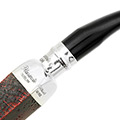 Typically used to refer to an army mount where the stem's tenon, as well as the end of the shank are clad in metal (usually sterling silver).
Typically used to refer to an army mount where the stem's tenon, as well as the end of the shank are clad in metal (usually sterling silver).
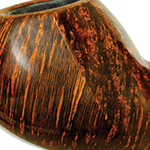 Stain is pigment, either vegetable or mineral, applied to the outside of a pipe to achieve a particular coloring.
Stain is pigment, either vegetable or mineral, applied to the outside of a pipe to achieve a particular coloring.
 The stem is the part of the pipe that connects the shank with the bit.
The stem is the part of the pipe that connects the shank with the bit.
 Straight indicates a pipe without bend to the shank or stem.
Straight indicates a pipe without bend to the shank or stem.
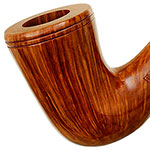 Straight grain is so densely packed together that it runs in perfect straight lines, as opposed to the somewhat wavy flame-grain.
Straight grain is so densely packed together that it runs in perfect straight lines, as opposed to the somewhat wavy flame-grain.
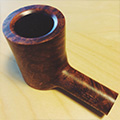 The main body of the pipe, consisting of bowl, transition, and shank taken together, and excluding the stem and any other accoutrements (accents, mounts, wind-caps, etc.).
The main body of the pipe, consisting of bowl, transition, and shank taken together, and excluding the stem and any other accoutrements (accents, mounts, wind-caps, etc.).
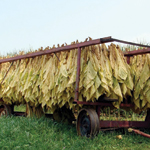 Sun curing is the drying of tobacco leaf in the Sun. Of all Sun-cured tobaccos, the best known are the so-called oriental tobaccos of Turkey, Greece, Yugoslavia, and nearby countries. They are low in both sugar and nicotine.
Sun curing is the drying of tobacco leaf in the Sun. Of all Sun-cured tobaccos, the best known are the so-called oriental tobaccos of Turkey, Greece, Yugoslavia, and nearby countries. They are low in both sugar and nicotine.
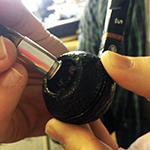 To tamp is to gently pack down the burning tobacco in a lit pipe. Doing so keeps the smoldering tobacco in contact with the unlit tobacco, keeping your pipe from going out.
To tamp is to gently pack down the burning tobacco in a lit pipe. Doing so keeps the smoldering tobacco in contact with the unlit tobacco, keeping your pipe from going out.
 A tamper is a pipe-tool used to tamp or gently pack down the burning tobacco in a lit pipe. Doing so keeps the smoldering tobacco in contact with the unlit tobacco, keeping your pipe from going out.
A tamper is a pipe-tool used to tamp or gently pack down the burning tobacco in a lit pipe. Doing so keeps the smoldering tobacco in contact with the unlit tobacco, keeping your pipe from going out.
 This refers simply to a stem that is tapered from base to bit, as opposed to a saddle stem, and may be circular, oval, paneled, or some other form (such as tear-drop shaped) in cross-section.
This refers simply to a stem that is tapered from base to bit, as opposed to a saddle stem, and may be circular, oval, paneled, or some other form (such as tear-drop shaped) in cross-section.
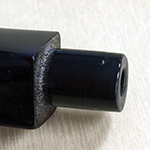 The tenon is the projection on the end of the mouthpiece/stem which fits into the mortise on the bowl of the pipe.
The tenon is the projection on the end of the mouthpiece/stem which fits into the mortise on the bowl of the pipe.
 Similar to the Apple and Ball shapes in its rotundity, the Tomato shape features a fully rounded bowl, just set at a far lower and squatter orientation. They are usually rendered in more muscular, chubby proportions, and they can come in both straight and bent configurations.
Similar to the Apple and Ball shapes in its rotundity, the Tomato shape features a fully rounded bowl, just set at a far lower and squatter orientation. They are usually rendered in more muscular, chubby proportions, and they can come in both straight and bent configurations.
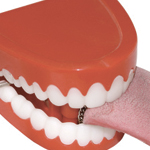 Tongue bite is a burning sensation on the smoker's tongue, previously thought to be due to the heat of the smoke, but now known to be the result of chemical burn.
Tongue bite is a burning sensation on the smoker's tongue, previously thought to be due to the heat of the smoke, but now known to be the result of chemical burn.
 Transition usually refers to the junction between the bowl and the shank of a pipe, but it is also used when referencing any planar change within a composition, such as that between the shank and stem.
Transition usually refers to the junction between the bowl and the shank of a pipe, but it is also used when referencing any planar change within a composition, such as that between the shank and stem.
 A Twist refers to tobacco that is moistened and twisted into a rope form. If a long rope of tobacco is twisted enough, it wraps around itself. This is one of the earliest examples of transporting tobacco for personal use. Twisted tobacco could be cut off to be chewed (as was often done on ships or in mines), or it could be cut with a knife which would make ribbons of tobacco to put in a pipe. Twisted tobacco not only made it easier to throw in a bag or pocket for travel, but made it much easier to transport than processed ribbons or whole leaf.
A Twist refers to tobacco that is moistened and twisted into a rope form. If a long rope of tobacco is twisted enough, it wraps around itself. This is one of the earliest examples of transporting tobacco for personal use. Twisted tobacco could be cut off to be chewed (as was often done on ships or in mines), or it could be cut with a knife which would make ribbons of tobacco to put in a pipe. Twisted tobacco not only made it easier to throw in a bag or pocket for travel, but made it much easier to transport than processed ribbons or whole leaf.
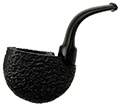 An unusual and compact shape whose closest relative would be the Opera/Oval, the Vestpocket is defined by an oval or oblong bowl, flat on the sides, with no discernable shank. The draft-hole is instead simply drilled at a downward angle from the back of the bowl and into the chamber, with the stem mounted vertically and bent to roughly 90 degrees. This makes for a pipe that's easy to hang from the jaw, and with the stem rotated so that the bit hangs over the bowl, one that fits very easily into a pocket. Like the Opera/Oval, these are also commonly found with oval-shaped tobacco chambers.
An unusual and compact shape whose closest relative would be the Opera/Oval, the Vestpocket is defined by an oval or oblong bowl, flat on the sides, with no discernable shank. The draft-hole is instead simply drilled at a downward angle from the back of the bowl and into the chamber, with the stem mounted vertically and bent to roughly 90 degrees. This makes for a pipe that's easy to hang from the jaw, and with the stem rotated so that the bit hangs over the bowl, one that fits very easily into a pocket. Like the Opera/Oval, these are also commonly found with oval-shaped tobacco chambers.
 Virginia is by far the most popular tobacco type used in pipe tobacco today. About 60% of the nation's tobacco crop is Virginia. Virginia is the mildest of all blending tobaccos and has the highest level of natural dextrose (sugar), which basically gives it a light sweet taste. Virginia is used in virtually all blends, burns easily, and aids in lighting. Pure Virginia tobacco is commonly enjoyed in flake types or ribbon cuts.
Virginia is by far the most popular tobacco type used in pipe tobacco today. About 60% of the nation's tobacco crop is Virginia. Virginia is the mildest of all blending tobaccos and has the highest level of natural dextrose (sugar), which basically gives it a light sweet taste. Virginia is used in virtually all blends, burns easily, and aids in lighting. Pure Virginia tobacco is commonly enjoyed in flake types or ribbon cuts.
 The classic Volcano is defined simply by a bowl that resembles its namesake; flat on the bottom, with a conspicuous and continuous taper upwards towards the rim, rather like a Dublin bowl rearranged upside-down. Artistic reinterpretations of the Volcano shape are popular amongst modern Danish artisans, and even more so in Japanese pipemaking, where bowls may for example be modeled after Mt. Fuji, or modified with curving lines to more resemble a cresting wave.
The classic Volcano is defined simply by a bowl that resembles its namesake; flat on the bottom, with a conspicuous and continuous taper upwards towards the rim, rather like a Dublin bowl rearranged upside-down. Artistic reinterpretations of the Volcano shape are popular amongst modern Danish artisans, and even more so in Japanese pipemaking, where bowls may for example be modeled after Mt. Fuji, or modified with curving lines to more resemble a cresting wave.
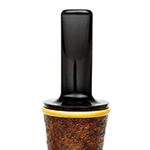 Vulcanite and Ebonite are essentially the same material: vulcanized rubber. The process of vulcanization converts natural rubber into a harder and more durable material. Ebonite was simply a brand name obtained by Charles Goodyear for the vulcanized rubber material. The addition of sulfur is what leads to this material oxidizing (turning yellowish or brownish - which can easily be polished away). There are a variety of industrial uses for vulcanite (sheets and rods), which is what pipe makers use to craft a 'hand cut' stem. Vulcanite can also be a liquid cast. "Pre-form" stems are made from injecting liquid vulcanite into a mold, resulting in a 'cast' stem. Many pipe makers use high-quality vulcanized rods due to the microscopic exclusion of bubbles and, therefore, much slower oxidation. Ebonite and Vulcanite are used among pipe makers and factories interchangeably for the same product.
Vulcanite and Ebonite are essentially the same material: vulcanized rubber. The process of vulcanization converts natural rubber into a harder and more durable material. Ebonite was simply a brand name obtained by Charles Goodyear for the vulcanized rubber material. The addition of sulfur is what leads to this material oxidizing (turning yellowish or brownish - which can easily be polished away). There are a variety of industrial uses for vulcanite (sheets and rods), which is what pipe makers use to craft a 'hand cut' stem. Vulcanite can also be a liquid cast. "Pre-form" stems are made from injecting liquid vulcanite into a mold, resulting in a 'cast' stem. Many pipe makers use high-quality vulcanized rods due to the microscopic exclusion of bubbles and, therefore, much slower oxidation. Ebonite and Vulcanite are used among pipe makers and factories interchangeably for the same product.
 See Zulu.
See Zulu.
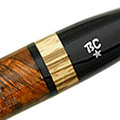 A common name for several species of hardwood bearing distinctively bold stripes in their grain pattern, and which have become popular accent materials for smoking pipes.
A common name for several species of hardwood bearing distinctively bold stripes in their grain pattern, and which have become popular accent materials for smoking pipes.